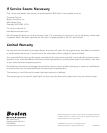
use
c
rossover
control *
T 1.5A L 250V
C
AUTION: Disconnect supply cord
b
efore replacing fuse. For continued
protection against risk of fire, replace only
with same type fuse.
ATTENTION: Debrancher avant de
r
emplacer le fusible. Utiliser un fusible de
r
echange de même type.
1
20V ~ 60Hz 1.25A
bypass
c
rossover
control **
7
5
1
00 125
150
*
use crossover control: removes high
frequencies; use with sources lacking suitable
f
iltering (most products without Dolby Digital
or THX), or where manual control is desired.
crossover (Hz)
p
ower
0
º
180 º
polarity
l
eft right
s
peaker level in
Powered Subwoofer featuring BassTrac
®
l
ine level in
** bypass crossover control: direct to woofer;
u
se with sources having built-in crossover
controls or bass management (most products
w
ith Dolby Digital or THX).
C US
XB4
CAUTION
RISK OF ELECTRIC SHOCK
DO NOT OPEN
AVIS: RISQUE DE CHOC ELECTRIQUE-NE PAS OUVRIR
back of receiver
subwoofer out
use
crossover
control *
T 1.5A L 250V
CAUTION: Disconnect supply cord
before replacing fuse. For continued
protection against risk of fire, replace only
with same type fuse.
ATTENTION: Debrancher avant de
remplacer le fusible. Utiliser un fusible de
rechange de même type.
120V ~ 60Hz 1.25A
bypass
crossover
control **
75
100 125
150
* use crossover control: removes high
frequencies; use with sources lacking suitable
filtering (most products without Dolby Digital
or THX), or where manual control is desired.
crossover (Hz)
power
0º
180 º
polarity
left right
speaker level in
Powered Subwoofer
Featuring BassTrac
®
line level in
** bypass crossover control: direct to woofer;
use with sources having built-in crossover
controls or bass management (most products
with Dolby Digital or THX).
C US
XB4
CAUTION
RISK OF ELECTRIC SHOCK
DO NO T OPEN
AVIS: RISQUE DE CHOC ELECTRIQUE-NE PAS OUVRIR
RL RR
FRONT A
LL
SURROUNDFRONT B CENTER
SPEAKER SYSTEMS
FRONT A OR B, CENTER, SURR, SURR BACK
: MINIMUM
6 OHMS
FRONT A AND B : MINIMUM 8 OHMS
5
Connecting the Subwoofer to Digital Home Theater Systems
Digital 5.1, 6.1 and 7.1 home theater electronics dedicate one channel (the “.1”) to reproduce the special
low-frequency (LFE) information (such as explosions and thunder) contained in digitally-encoded soundtracks.
Select ”subwoofer-yes“ from your receiver’s set-up menu. Connected this way, the receiver’s amplifier is relieved
of having to reproduce the difficult low bass signals that can drive the receiver into audible distortion.
Use an RCA cable (not included), as shown, to connect your digital receiver’s subwoofer output to the subwoofer.
Connect the other end to the XB4 jack labeled “bypass crossover control” underneath “line level in”.
Be sur
e to connect
+ to + (r
ed) and
– to – (black).
If you do not wish to run RCA cables to your subwoofer, you may use speaker wire to connect the subwoofer in
parallel with your main speakers (see diagram below). The subwoofer does not present any additional load to your
receiver.
Select “subwoofer-no” from your receiver’s set-up menu. This sends the LFE signal to the main left and right
speakers, and thus, to the subwoofer. Consult your receiver’s owner’s manual for more details.
When using the speaker wire hookup, the subwoofer’s built-in crossover is engaged. As a starting point, set the
crossover control on the subwoofer about 10Hz higher than the lower limit of your main speakers’ bass response.
Fine-tune the crossover setting by ear for the smoothest blend with your main speakers. The best setting of the
crossover control will depend on speaker placement and personal preference.
back of receiver
leftright
front
speakers
to main speakers


















